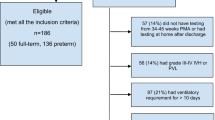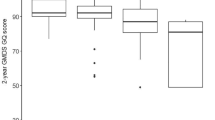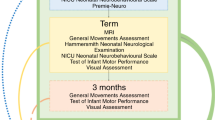Abstract
Objective:
Preterm infants are at risk for neurodevelopmental impairment. The Neonatal Intensive Care Unit Network Neurobehavioral Scale (NNNS) is a standardized assessment for the neurobehavioral integrity of the newborn. The use of NNNS as a prognostic tool is still emerging. We hypothesized that the NNNS examination performed at term equivalent can detect neurobehavioral alterations in very low birth weight infants and can help in predicting their neurodevelopmental outcome at 18 months corrected age (CA).
Study Design:
This is a prospective study that included preterm infants with birth weight <1500 g and gestational age ⩽34 weeks. They were evaluated with NNNS at term-equivalent and 12 summary scores were assigned. Infants who had 2 or more NNNS summary scores that were 2 s.d. beyond the mean of the study group were categorized as having abnormal NNNS. Mental Developmental Index (MDI) and Psychomotor Developmental Index (PDI) of Bayley Scales of Infant Development (BSID-II) were determined at 18 months CA. Multiple linear regression models were used to examine the predictivity of the NNNS summary scores for both MDI and PDI.
Result:
A total of 41 infants were evaluated at term and at 18 months CA. The average MDI was 78±15 and the average PDI was 80±14. Significant neurodevelopmental delay was observed in 50% and 31% of infants with abnormal and normal NNNS, respectively. Using multiple linear regression, NNNS was predictive for both MDI (P=0.011, adjusted R2=0.295) and PDI (P=0.002, adjusted R2=0.441). Lower MDI was associated with less regulation and more nonoptimal reflexes, whereas lower PDI was associated with less regulation, more nonoptimal reflexes, hypertonicity and handling.
Conclusion:
NNNS at term-equivalent age can detect neurobehavioral alterations in very low birth weight infants. Individual summary scores showed significant correlation with both the MDI and PDI at 18 months CA.
This is a preview of subscription content, access via your institution
Access options
Subscribe to this journal
Receive 12 print issues and online access
$259.00 per year
only $21.58 per issue
Buy this article
- Purchase on Springer Link
- Instant access to full article PDF
Prices may be subject to local taxes which are calculated during checkout
Similar content being viewed by others
References
Tyson JE, Parikh NA, Langer J, Green C, Higgins RD . Intensive care for extreme prematurity--moving beyond gestational age. N Engl J Med 2008; 358 (16): 1672–1681.
El-Dib M, Massaro AN, Bulas D, Aly H . Neuroimaging and neurodevelopmental outcome of premature infants. Am J Perinatol 2010; 27 (10): 803–818.
El-Dib M, Massaro AN, Aly H . Electroencephalography, amplitude-integrated electroencephalography and neurodevelopmental outcome in premature infants, In: B F, F M (eds). Neuroscience Research Advances. Nova Science Publishers, Inc.: New York, 2010; pp 109–134.
El-Dib M, Massaro AN, Glass P, Aly H . Neurodevelopmental assessment of the newborn: an opportunity for prediction of outcome. Brain Dev 2011; 33 (2): 95–105.
Lester BM, Tronick EZ, LaGasse L, Seifer R, Bauer CR, Shankaran S et al. The maternal lifestyle study: effects of substance exposure during pregnancy on neurodevelopmental outcome in 1-month-old infants. Pediatrics 2002; 110 (6 I): 1182–1192.
Lester BM, Tronick EZ . History and description of the neonatal intensive care unit network neurobehavioral scale. Pediatrics 2004; 113 (3 part 2): 634–640.
Lester BM, Tronick EZ, Brazelton TB . The neonatal intensive care unit network neurobehavioral scale procedures. Pediatrics 2004; 113 (3 part 2): 641–667.
Lester BM, Tronick EZ . Appendix 2 2: Neonatal Intensive Care Unit Network Neurobehavioral Scale Summary Score Definitions. Pediatrics 2004; 113 (3): 694.
Tronick EZ, Olson K, Rosenberg R, Bohne L, Lu J, Lester BM . Normative neurobehavioral performance of healthy infants on the neonatal intensive care unit network neurobehavioral scale. Pediatrics 2004; 113 (3): 676–678.
Stephens BE, Liu J, Lester B, Lagasse L, Shankaran S, Bada H et al. Neurobehavioral assessment predicts motor outcome in preterm infants. J Pediatr 2010; 156 (3): 366–371.
Bayley N . Bayley Scales of Infant Development. The Psychological Corporation: San Antonio, TX, 1993.
Napiorkowski B, Lester BM, Freier MC, Brunner S, Dietz L, Nadra A et al. Effects of in utero substance exposure on infant neurobehavior. Pediatrics 1996; 98 (1): 71–75.
Coyle MG, Ferguson A, LaGasse L, Liu J, Lester B . Neurobehavioral effects of treatment for opiate withdrawal. Arch Dis Child Fetal Neonatal Ed 2005; 90 (1): F73–F74.
Law KL, Stroud LR, LaGasse LL, Niaura R, Liu J, Lester BM . Smoking during pregnancy and newborn neurobehavior. Pediatrics 2003; 111 (6 Part 1): 1318–1323.
Liu J, Bann C, Lester B, Tronick E, Das A, Lagasse L et al. Neonatal neurobehavior predicts medical and behavioral outcome. Pediatrics 2010; 125 (1): e90–e98.
Lester BM, Bagner DM, Liu J, LaGasse LL, Seifer R, Bauer CR et al. Infant neurobehavioral dysregulation: behavior problems in children with prenatal substance exposure. Pediatrics 2009; 124 (5): 1355–1362.
Brown NC, Doyle LW, Bear MJ, Inder TE . Alterations in neurobehavior at term reflect differing perinatal exposures in very preterm infants. Pediatrics 2006; 118 (6): 2461–2471.
Brown NC, Inder TE, Bear MJ, Hunt RW, Anderson PJ, Doyle LW . Neurobehavior at term and white and gray matter abnormalities in very preterm infants. J Pediatr 2009; 155 (1): 32–38, 38 e31.
Acknowledgements
This study was partially supported by Grant 5 M01-RR020359 from the General Clinical Research Center Program of the National Center for Research Resources, National Institute of Health (PI: M El-Dib), Research Advisory Committee Award, Children's National Medical Center (PI: M El-Dib) and Discovery Labs Neonatal Fellowship Grant from Discovery Laboratories (FY2005, PI: A Massaro).
Author information
Authors and Affiliations
Corresponding author
Ethics declarations
Competing interests
The authors declare no conflict of interest.
Rights and permissions
About this article
Cite this article
El-Dib, M., Massaro, A., Glass, P. et al. Neurobehavioral assessment as a predictor of neurodevelopmental outcome in preterm infants. J Perinatol 32, 299–303 (2012). https://doi.org/10.1038/jp.2011.100
Received:
Revised:
Accepted:
Published:
Issue Date:
DOI: https://doi.org/10.1038/jp.2011.100
Keywords
This article is cited by
-
Effectiveness of interventions on early neurodevelopment of preterm infants: a systematic review and meta-analysis
BMC Pediatrics (2021)
-
Early clinical and MRI biomarkers of cognitive and motor outcomes in very preterm born infants
Pediatric Research (2021)
-
Psychosocial and medical adversity associated with neonatal neurobehavior in infants born before 30 weeks gestation
Pediatric Research (2020)
-
Longer duration of kangaroo care improves neurobehavioral performance and feeding in preterm infants: a randomized controlled trial
Pediatric Research (2020)
-
Neurobehavior of preterm infants from 32 to 48 weeks post-menstrual age
Journal of Perinatology (2019)



